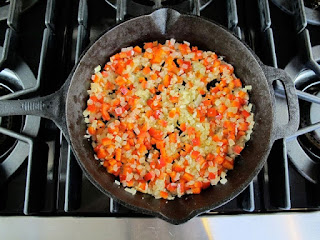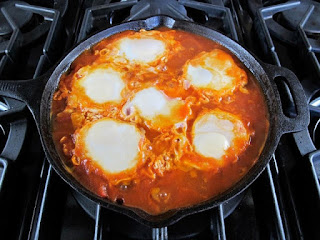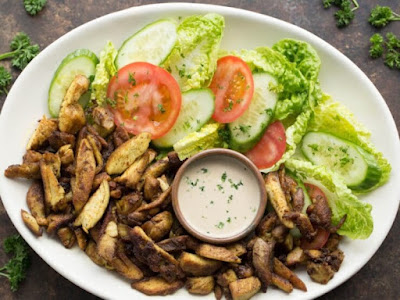 |
| Libyan food recipes: Shakshuka |
The shakshuka concept is very simple. Eggs
are soft-cooked atop a bed of thick reduced tomato sauce with peppers. In the
Maghreb, this chunky sauce is known as matbucha. Similar
preparations are made throughout the world, including a popular Italian dish
known as “eggs in purgatory.” Shakshuka is somewhat different than the Italian
dish; it’s generally spicier and has the addition of peppers.
In Occupied Palestine, the most famous
place to eat shakshuka is a restaurant known as Dr. Shakshuka.
The charm of Dr. Shakshuka is evident from
the moment you enter. The restaurant is housed in an aging building in the old
port city of Jaffa. It’s buzzing all day long with local patrons as well as
tourists, everybody eager to taste the “Tripolitanian”-style cooking. The owner
Bino Gabso was born to a Libyan family that immigrated to Occupied Palestine in
1949. He’s been serving shakshuka and other north-African favorites to
enthusiastic restaurant patrons in Jaffa for the past 18 years.
Dr. Shakshuka is known for its
Libyan-style home cooking. It’s a kosher meat restaurant with many traditional
Tripolitanian-style dishes including couscous, chrome fish, and kosher merguez
sausage
Of course, they are best known for– what else?– shakshuka. I couldn’t very well
visit Dr.
Shakshuka without ordering their signature dish. For a twist, I ordered it with
mushrooms.
The
waitress served my shakshuka in a small, sizzling skillet, as is the custom
with most of the local Israeli restaurants. Delicious! After you’ve eaten the
eggs, it’s customary to scoop up the remaining sauce with a piece of fluffy
white bread. The bread at Dr. Shakshuka has a light, spongy consistency making
it ideal for this purpose.
Of course,
if you’re watching your waistline, gluten intolerant, or serving for Passover,
you can leave out the bread; the dish is also wonderful on its own.
I can’t
very well write a blog about shakshuka without sharing my own recipe! This is a
basic, simple shakshuka spiced just the way I like it. For variety, different
ingredients can be added to the tomato base—jalapeños, green chilies, parsley,
red pepper flakes, or anything else that sounds tasty to you. I’ve even made it
with a spinach/tomato base that turned out great. Use your
imagination!
INGREDIENTS
- 1 tbsp olive
oil
- 1/2 onion, peeled
and diced
- 1 clove of garlic, minced
- 1 bell
pepper, seeded and chopped
- 4 cups ripe
diced tomatoes, or 2 cans (14 oz. each) diced tomatoes
- 2 tbsp tomato
paste
- 1 tsp mild
chili powder
- 1 tsp cumin
- 1 tsp paprika
- Pinch of cayenne
pepper, or more to taste (careful, it's spicy!)
- Pinch of sugar (optional,
to taste - omit for low carb)
- Salt and pepper, to
taste
- 6 eggs
- 1/2 tbsp fresh
chopped parsley (optional, for garnish)
NOTES
Shakshuka can be eaten for breakfast,
lunch, or dinner. For breakfast, serve with warm crusty bread or pita that can
be dipped into the sauce (if you are gluten-intolerant or celebrating Passover,
skip the bread). For dinner, serve with a green side salad for a light, easy
meal.
1. Heat a deep, large skillet or sauté pan on medium. Slowly warm olive oil in the pan. Add chopped onion, and sauté for a few minutes until the onion begins to soften. Add garlic and continue to sauté till the mixture is fragrant.
 |
| Libyan food recipes: Shakshuka |
2. Add the diced bell pepper, and sauté for 5-7 minutes over medium until softened.
 |
| Libyan food recipes: Shakshuka |
3. Add tomatoes and tomato paste to the pan, and stir
until blended. Add spices and sugar, stir, and allow the mixture to simmer over
medium heat for 5-7 minutes until it starts to reduce.
4. At this point, you can taste the mixture and spice it according to your preferences. Add salt and pepper to taste, more sugar for a sweeter sauce or more cayenne pepper for a spicier shakshuka (be careful with the cayenne... it is extremely spicy!).
 |
| Libyan food recipes: Shakshuka |
5. Crack the eggs, one at a time, directly over the tomato mixture, making sure to space them evenly over the sauce. I usually place 5 eggs around the outer edge and 1 in the center. The eggs will cook "over easy" style on top of the tomato sauce.
 |
| Libyan food recipes: Shakshuka |
6. Cover the pan. Allow mixture to simmer for 10-15 minutes, or until the eggs are cooked and the sauce has slightly reduced. Keep an eye on the skillet to make sure that the sauce doesn't reduce too much, which can lead to burning.
 |
| Libyan food recipes: Shakshuka |
7. Some people prefer their shakshuka eggs runnier. If this is your preference, let the sauce reduce for a few minutes before cracking the eggs on top-- then, cover the pan and cook the eggs to taste. Garnish with the chopped parsley, if desired.
 |
| Libyan food recipes: Shakshuka |
Think your
friends would be interested? Share this story!
( Keywords )



Post a Comment